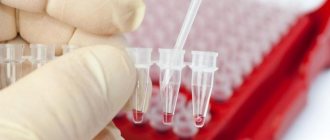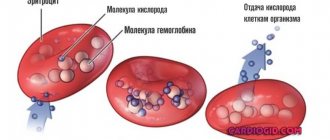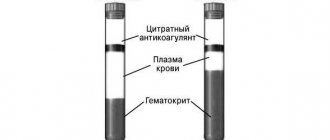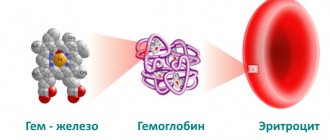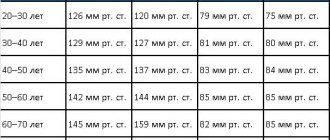The abbreviation ESR stands for “erythrocyte sedimentation rate,” measured in millimeters per hour. (In old reference books this analysis was called ROE). The research is based on a process caused by gravitational forces. Since red blood cells are heavier than other blood elements, they are the first to precipitate. Their counting in a vertically placed test tube after an hour is the basis of the analysis.
The speed at which red blood cells sink to the bottom depends on many factors, both physiological and pathological. ESR values differ depending on age and gender. Changes in indicators are possible due to dietary habits, the patient undergoing a course of treatment with certain types of medications, corticosteroids, and anti-inflammatory drugs.
Knowing what a high ESR indicates is especially important, since exceeding the standards most often indicates the development of a particular disease. High ESR numbers may indicate the presence of oncopathology, inflammatory process, infectious, rheumatological, or anemia in the body. The indicator will exceed the norm in case of myocardial infarction, trauma, allergies, pregnancy.
Despite the fact that ESR is a nonspecific indicator, the diagnostic value of the study is enormous. This is due to its high sensitivity. A change in this indicator is noted already in the early stages of the development of the pathological process, when other tests are not yet informative and remain normal. An increased ESR in a blood test is a reason to continue the examination and clarify the situation.
Why does the parameter value increase?
The reasons why the value of the ESR parameter increases in women is normal:
- menstrual period;
- use of oral contraceptives;
- pregnancy;
- postpartum period.
In women over 50 years of age, the increase in ESR is associated with hormonal changes in the body as menopause approaches.
In a child, the ESR value depends on his age. In a newborn, the maximum value is 2.8 mm/h, which is associated with a very low protein concentration in the blood, and therefore the lack of conditions for red blood cells to quickly settle. Since blood viscosity increases with the development of a child, by the age of 14 this figure in girls becomes 2-15 mm/h, in boys - 1-10 mm/h.
What does ESR show?
The erythrocyte sedimentation rate is determined in the laboratory after blood is drawn from the patient. Leave the material for 60 minutes and see how quickly the bodies appear at the bottom of the tube. Measurements are carried out in millimeters per hour.
Let's take a closer look at the process.
Blood is a fluid that circulates through vessels in the body. It is heterogeneous and consists of the following elements:
- erythrocytes - red cells;
- white leukocytes;
- lymphocytes;
- plasma is a clear liquid with a salty taste in which proteins are dissolved.
We will not analyze the entire composition. Within the framework of the topic, the main thing is the presence of erythrocytes in the liquid - red cells, which carry oxygen throughout the organs and tissues.
As blood moves through the body, all its components mix. Red blood cells color the composition red. If blood is placed in a tall test tube, the liquid will begin to “stratify.” Leukocytes and red blood cells are relatively heavy, so they sink to the bottom of the vessel in which they are located - they settle. Laboratories measure the speed of the process.
If the body is healthy, then everything happens slowly. In the case of inflammation, for example, the following are produced:
- immunoglobulins;
- fibrinogen is a protein that is involved in the wound healing process.
These substances attach to red blood cells, so the mass of red cells increases. There is an increase in ESR.
It is not necessary that the erythrocyte sedimentation rate increases due to inflammation or coronavirus. But this should be considered as an indication for other tests.
ESR is a nonspecific marker. This means that it is impossible to say exactly what is happening to the body. Doctors have noticed that most often the erythrocyte sedimentation rate becomes higher in rheumatic diseases:
- arthritis;
- lupus;
- vasculitis.
The higher the ESR, the worse the situation. For example, in a normal state, the erythrocyte sedimentation rate may be 25. If the ESR is 40, this is a reason for an extended examination.
Please note that with coronavirus infection, the same thing happens as with rheumatism: the immune system does not work correctly and attacks the body, destroying tissues and organs. An ESR of 80 or 100 can occur with severe suppuration, a cancerous tumor, pneumonia, including that which arose as a complication of COVID-19.
The reasons for the increase in the rate of sedimentation of blood particles may be:
- decay and death of tissues, purulent processes;
- metabolic disorders, diabetes;
- liver pathologies, blood loss, exhaustion;
- anemia;
- hormonal changes in a woman’s body.
The erythrocyte sedimentation rate may be less than normal. The following reasons:
- dysfunction of the circulatory system, weak production of red cells, changes in their shape, etc.;
- heredity;
- psychological and psychiatric problems;
- the effect of medications on the body.
During and after COVID-19, a high ESR or ROE is characteristic - the erythrocyte sedimentation reaction. This is explained by the fact that coronavirus is a disease that affects not only the respiratory system, but also other systems of the body. Covid affects everything at once, causing complications.
Analysis transcript
All standard ESR indicators are available in a special table, where they are indicated in accordance with gender and age. In this case, only a doctor should interpret the answer received, since the result of the study can vary in any direction depending on physiological or pathological processes. To assess the situation, the specialist will take into account a whole range of related factors. At the same time, you need to know that in 5% of the world's inhabitants, the analysis shows a high ESR for no apparent reason.
| Age | Norm, mm/h |
| up to 13 years old | 4-12 mm/h |
| 13-18 years old | 3-18 mm/h |
| 18-30 years old | 2-15 mm/h |
| 30-40 years | 2-20 mm/h |
| 40-50 years | 0-26 mm/h |
| 50-60 years | 0-26 mm/h |
| after 60 years | 2-55 mm/h |
| During pregnancy | up to 45 mm/h |
How to reduce ESR after illness
The rate of “red blood cell precipitation” can be normalized after identifying and eliminating the root cause. For example, if a complication affects the legs or joints, they need to be treated. After suffering from pneumonia, it is necessary to cope with its consequences. When heart pain occurs, you need to address cardiac problems. There is no universal solution here.
If the ESR is high, then in many cases antibiotics are prescribed. They are sold with a doctor's prescription. But in our country anything is possible, so we warn you: do not self-medicate. You should only take medications if they have been prescribed by a doctor.
There is a lot of information on the Internet about how to lower ESR at home using traditional methods. No need to follow advice. There is no “control knob” for the level of erythrocyte sedimentation rate. As noted at the very beginning of the article, an increase in ESR is only a marker. It shows that not everything is in order with the body, except for the following exceptions:
- pregnancy, menstruation period;
- fatigue not related to Covid;
- exhausting workouts;
- binge eating.
Together with the doctor, you need to look for the root cause and eliminate it. Then the ESR will return to normal.
What does ROE depend on?
The ability of red blood cells to settle without the participation of the blood coagulation system depends on two factors:
- Structure and number of erythrocyte cells;
- Plasma composition.
Healthy red blood cells have a negative charge on their surface. This allows them to circulate freely in the riverbed, pushing away from each other. When immune cells and mechanisms are activated in the body, this leads to an increase in the amount of immunoglobulins and fibrinogen in the plasma. On the one hand, they increase the density and viscosity of the plasma, and on the other, they change the surface charge of red blood cells. The natural consequence of such changes is the formation of large and heavy erythrocyte conglomerates in the vessels, which are able to settle much faster under the influence of gravity.
The situation changes exactly the opposite if the blood plasma becomes thicker. Red blood cells in such an environment are not able to settle, being in a suspended state. The higher the density of the plasma, the less opportunity there is for sedimentation, even for erythrocyte accumulations.
The adhesion of red blood cells to each other is the main mechanism for increasing RER during immune-inflammatory reactions in the body
Additional examinations if the ESR deviates from the norm
Supporting activities include the following methods:
- Oral interview with a person. It is necessary to identify complaints and symptoms of the alleged pathological process.
- Anamnesis collection. To determine the characteristic origin of the disorder. The issue is resolved quickly, right in the doctor’s office. But the results allow us to develop a further diagnostic strategy.
- Biochemistry of venous blood. To find specific markers of autoimmune inflammation, as well as other indicators like bilirubin.
- Ultrasound of the digestive tract. To detect possible gastrointestinal pathologies.
- Serological tests, PCR, ELISA. Within the framework of these methods, infectious processes are studied.
- Chest X-ray.
- Blood test for thyroid hormones, specific sex substances (estrogens).
Usually this is enough.
Physiological factors influencing the indicator
Acceleration of ROE, as a norm, can be perceived in the following situations:
- During pregnancy and breastfeeding;
- Anemia;
- While taking hormonal contraceptives;
- Diet or fasting;
- Obesity and high cholesterol;
- The period after vaccination or recovery from infectious diseases;
- The temperature regime in the conditions where the study was carried out was more than 27˚C;
- Taking vitamins;
- In children and the elderly.
The following can slow down ROE:
- Increased number of red blood cells or other cellular components of the blood (polycythemia, erythremia);
- Hereditary changes in red blood cells in the form of small sizes and irregular shapes;
- Prem non-steroidal anti-inflammatory drugs;
- Severe heart failure;
- The temperature regime in the conditions where the study was conducted was less than 22˚C.
At what level should you consult a doctor?
Repeated high ROE readings (above 30 mm/hour) require contacting a therapist. The doctor will weigh the possible reasons for the increase and prescribe additional examinations. If a specific pathology is suspected, a referral is issued to a specialist who conducts a detailed examination of the diseased organ.
The main goal of the examination is to find the cause of the anomaly and not to miss the early stage of a dangerous disease. In some situations, it is not possible to find out the reason for the increase in ROE. In this case, they take a wait-and-see position and watch the indicator over time.
How to get it back to normal
Reducing ESR without finding out the reasons for the increase in the indicator does not make sense. ROE is not a disease, but a diagnostic parameter indicating problems in the body. Self-medication is especially dangerous.
Medications
Some medications have the effect of reducing ROE in the body:
- Aspirin and other medicines containing salicylic acid;
- Calcium chloride;
- mercury-containing preparations;
- antihistamines.
The attending physician makes a diagnosis, as a result of which the ROE level was increased. Treatment of the underlying disease will help normalize the indicator. For infectious pathologies and their complications, antibiotics are usually prescribed: Metronidazole, Tetracycline, Levomycetin, Erythromycin.
For inflammatory lesions of the joints and spine, non-steroidal anti-inflammatory drugs are most effective. The most popular are Diclofenac, Ibuprofen, Indomethacin. New generation drugs that have a gentle effect on the gastrointestinal tract—Meloxicam, Arcoxia.
Indicators of anemia are corrected with the help of medications containing hemoglobin and folic acid: Hemodin, Irovit, Maltofer.
For tuberculosis, drugs active against Koch's bacillus are used: Isoniazid, Rifampicin, Parazinamide. Treatment of autoimmune and endocrine diseases requires specific therapy. Suspicion of a malignant tumor is the basis for immediately sending the patient for consultation to an oncology clinic.
ROE (normal blood levels in women by age), the table with the value of which shows their changes, in some cases can increase significantly. Temporary surges in ESR do not require treatment; after some time the indicator will return to normal on its own.
Traditional methods
To reduce the ESR, you can use folk remedies that will not cause harm to the body and will help strengthen the immune system. Consultation with your attending physician is advisable.
Lemon juice with chopped garlic—the mixture has an antimicrobial effect, improves immunity, and helps lower cholesterol. Mix 100 g of peeled garlic with juice squeezed from four lemons. The mixture should be stored in a cool place. 1 tsp Take the medication once a day before bed.
Honey is a unique natural product that promotes overall health of the body. Accepted according to Art. spoon in the morning or diluted in a glass of warm water.
Beets are rich in B vitamins, potassium, and beneficial microelements. Three well-washed root vegetables are boiled for 2-3 hours. Beetroot decoction is used as a medicine, which is drunk before meals, 2 tbsp. l., course of treatment 2 weeks.
A herbal collection of sea buckthorn berries, chamomile and calendula flowers has antispasmodic, bactericidal, and anti-inflammatory properties. 2 tbsp. l. berries and flowers are brought to a boil and left in a water bath for 20 minutes. Take 100 g before meals 2 times a day.
It is useful to drink herbal teas using coltsfoot grass, linden blossom, and raspberry leaf. Use honey instead of sugar.
Other methods
With minor fluctuations in ROE, a decrease can be achieved by changing your lifestyle in favor of healthy habits. Walking in the fresh air, moderate physical activity, proper nutrition and quitting smoking and alcohol improve laboratory blood counts.
A special diet has been developed to help reduce inflammation in the body and normalize metabolism. Add to the diet: beef, liver, legumes, nuts, beets, dried fruits, green vegetables.
Eating all types of citrus fruits and chocolate helps reduce ESR. Good results are achieved by a course of treatment with B vitamins. An effective drug is Milgamma.
All of the above methods work only with a slight increase in the ROE norm in a blood test in women according to the table. If the erythrocyte sedimentation reaction is more than 30 mm/hour, the attending physician must adjust the indicator.
What is ROE and its significance for the body
What is RO ESR (ESR)—erythrocyte sedimentation rate. The analysis is one of the main basic blood tests. A referral for examination is issued upon initial consultation with a doctor, before medical procedures or surgical interventions.
Laboratory essence of the method: healthy red blood cells precipitate slowly. Aggregated (glued) red blood cells have a greater mass and settle at a faster rate. Factors that indicate the activation of the immune response to pathology in the body lead to the sticking of red blood cells.
The erythrocyte sedimentation reaction is a nonspecific laboratory indicator that indirectly indicates pathological disorders in the body. Based on ROE, a final diagnosis cannot be made, but the direction of further research can be determined.
Why do you need to monitor your blood counts?
ESR is a marker that can indicate that something is wrong with the body. If the red blood cells become heavier and sink faster to the bottom of the test tube that is used for testing, you need to undergo an examination to determine what exactly caused the change in the indicator. It is necessary to fight not with the increase in erythrocyte sedimentation rate itself, but with the reasons that caused it. If you ignore changes in your body, you may miss the time needed to prevent severe complications from COVID-19.
You can undergo a complete diagnosis at La Salute. The clinic is equipped with equipment that provides accurate results. If complications are identified, you will also be able to undergo a rehabilitation course with us. La Salute specialists have developed techniques that help restore the body after coronavirus and prevent the development of complications that can worsen the patient’s quality of life.
Sign up for COVID-19 testing at La Salute clinic


